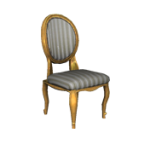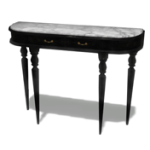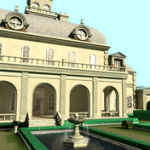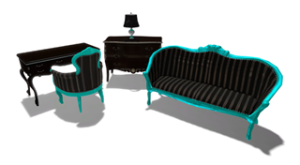Regency Style in Home
by Phoenix, HSM team writer
Some might wish to be more specific and refer to the subject material in this article as pertaining to the Georgian style — as opposed to the Regency style — but whichever you call it, Home has it.
The Georgian period of furniture and architecture was named for the reining Hanoverian kings of England, all of whom were named George, starting with King George the First, cousin to Queen Anne of England. Ths period is divided into three distinct periods: Early Georgian, Mid Georgian and Late Georgian. Each of these periods had its dominant elements. The pieces in the early Georgian period were influenced by the agricultural and architectural revolutions taking place in Europe at the time.
 This was a somewhat plain and austere style in the beginning: a simple statement of elegance was depicted for the monarch’s style, as he was thought of as a county gentleman at heart. Furniture of the mid-Georgian period, due to higher skill on the part of the craftsman, showed a decidedly more sophisticated design style. The late Georgian period is perhaps the period most familiar to people; it was influenced by the classical revival of Greek design and architecture.
This was a somewhat plain and austere style in the beginning: a simple statement of elegance was depicted for the monarch’s style, as he was thought of as a county gentleman at heart. Furniture of the mid-Georgian period, due to higher skill on the part of the craftsman, showed a decidedly more sophisticated design style. The late Georgian period is perhaps the period most familiar to people; it was influenced by the classical revival of Greek design and architecture.
The characteristics typical to Georgian furniture are small elegant legs, tables with drawers, and highly skilled marquetry or inlays in ovals and shields, containing mythological figures and classical symbols. Marquetry was often practiced with lighter woods like satinwood and maple. Table edges and chair frames were painted in bright colors, including grey, blue, white and green.
Wheels were added on much of the table and chair legs of the period for increased mobility. Three-legged tables became fashionable during the Regency period, named for King George IV. The Regency period, or the late Georgian period, was a period that saw a mixing of Greek, Egyptian and Asian influences in furniture and architecture as well as royal influences.
Other elements seen in this style of furniture were guilt, oval chair backs, or even medallion shapes. Legs went from curves in 1710 to straight columnar. Woods of dark mahogany (an influence of Queen Anne’s), satinwood, and ebony along with the guilt of gold became common sources for the heavy pieces. These woods — mahogany, in particular — were well suited for cabinets, tables and big pieces, as it is a hard and durable wood. Furnishings with these characteristics can be found in Home’s marketplace.
Home has a wide assortment of Georgian/Regency furnishing available from its developers. Lockwood has their Cucumber collection of furnishing. The Regency collection from Bigyama. There are a few other collections that would fit the  Georgian elements in design. The Waterfall Terrace collection tables have inlaid marquetry tops, as do the Assassin’s Creed pieces. If you’re thinking these tables and furnishings are the same tables as seen in the Art Deco period and a few others, then you are correct; this constant popularity of Georgian furnishings is a sign of a well made design.
Georgian elements in design. The Waterfall Terrace collection tables have inlaid marquetry tops, as do the Assassin’s Creed pieces. If you’re thinking these tables and furnishings are the same tables as seen in the Art Deco period and a few others, then you are correct; this constant popularity of Georgian furnishings is a sign of a well made design.
In the latter half of the 18th century, the woods used were exotic, coming from India and South America, creating the inlaying of decorative designs and details in veneer marquetry. Upholstery was done in silk, leather and horse hair. This was a common and expensive form of furniture production. Decorations included medallions, stripes in contrasting colors and sizes, along with flowers and patterns. The upholstery on the furnishings often matched the curtains and other textiles in the space. This is possible in Home with some of the new customization. Sofas were created with six and eight legs during this era, again carved from the dark woods of the time.
 Dominating colors were dark greens, blues grey, and burgundy, as the style progressed; these colors were lightened throughout the period of popularity. Gilding was seen on the accompanying accessories, mirrors, portrait frames, candle sticks and chandeliers, vases ornately designed and ornamented in brilliant contrasting colors. Frames were thinner and either rectangle or oval in shape, carrying the shape of the chairs along. The Georgians were not shy of color; the walls in their homes were painted in deep jewel tones, reds, greens sunny yellows with white crown molding and wainscoting.
Dominating colors were dark greens, blues grey, and burgundy, as the style progressed; these colors were lightened throughout the period of popularity. Gilding was seen on the accompanying accessories, mirrors, portrait frames, candle sticks and chandeliers, vases ornately designed and ornamented in brilliant contrasting colors. Frames were thinner and either rectangle or oval in shape, carrying the shape of the chairs along. The Georgians were not shy of color; the walls in their homes were painted in deep jewel tones, reds, greens sunny yellows with white crown molding and wainscoting.
If you’re a fan of these furnishing styles and you need a space to showcase your creativeness, there is more than one personal space that fits the design for this period in style. The French Chateau, the Abbey Hill Cottages, the Crystal Seashores Apartment, and — believe it or not — the City of Flowers Paris Apartment. All of these spaces would be a perfect backdrop for a Georgian/Regency styled design.
Share
| Tweet |


